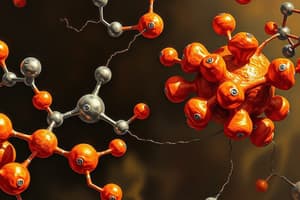Podcast
Questions and Answers
Which statement correctly describes the primary function of lipids in biological systems?
Which statement correctly describes the primary function of lipids in biological systems?
- They are primarily used for energy storage and signaling. (correct)
- They form long chains for structural support in cell walls.
- They function as the main structural components of enzymes.
- They are responsible for genetic information storage.
Which type of carbohydrate directly functions in energy storage in animals?
Which type of carbohydrate directly functions in energy storage in animals?
- Cellulose
- Glycogen (correct)
- Sucrose
- Glucose
What is the correct order of protein structure levels from simplest to most complex?
What is the correct order of protein structure levels from simplest to most complex?
- Primary, Secondary, Tertiary, Quaternary (correct)
- Secondary, Primary, Quaternary, Tertiary
- Primary, Tertiary, Quaternary, Secondary
- Tertiary, Quaternary, Primary, Secondary
Which component is NOT part of a nucleotide in nucleic acids?
Which component is NOT part of a nucleotide in nucleic acids?
Which macromolecule category includes enzymes, which facilitate biochemical reactions?
Which macromolecule category includes enzymes, which facilitate biochemical reactions?
Which of the following is a characteristic unique to saturated fatty acids?
Which of the following is a characteristic unique to saturated fatty acids?
How do monosaccharides primarily differ from polysaccharides?
How do monosaccharides primarily differ from polysaccharides?
What structural feature distinguishes RNA from DNA?
What structural feature distinguishes RNA from DNA?
Which category of macromolecules does not primarily contain carbon, hydrogen, and oxygen?
Which category of macromolecules does not primarily contain carbon, hydrogen, and oxygen?
Which group of amino acids would be classified as polar?
Which group of amino acids would be classified as polar?
Flashcards are hidden until you start studying
Study Notes
Macromolecules in Biology
Definition
- Macromolecules are large, complex molecules essential for life.
- Comprised of smaller units called monomers which polymerize to form larger structures.
Types of Macromolecules
-
Carbohydrates
- Composed of carbon, hydrogen, and oxygen (C, H, O).
- Functions:
- Energy storage (e.g., starch in plants, glycogen in animals).
- Structural roles (e.g., cellulose in plant cell walls).
- Categories:
- Monosaccharides (simple sugars like glucose).
- Disaccharides (two sugars, e.g., sucrose).
- Polysaccharides (long chains, e.g., starch, glycogen, cellulose).
-
Proteins
- Made up of amino acids (20 different types).
- Functions:
- Enzymatic activity (catalysts for biochemical reactions).
- Structural components (e.g., collagen in connective tissues).
- Transport (e.g., hemoglobin in blood).
- Defense (e.g., antibodies).
- Structure:
- Primary (amino acid sequence).
- Secondary (alpha helices and beta sheets).
- Tertiary (3D folding).
- Quaternary (multiple polypeptide chains).
-
Lipids
- Hydrophobic molecules, primarily composed of hydrocarbons.
- Functions:
- Energy storage (fats and oils).
- Structural components of cell membranes (phospholipids).
- Signaling molecules (steroids and hormones).
- Categories:
- Fatty acids (saturated and unsaturated).
- Triglycerides (glycerol + 3 fatty acids).
- Phospholipids (glycerol + 2 fatty acids + phosphate group).
- Steroids (four fused carbon rings).
-
Nucleic Acids
- Polymers made of nucleotide monomers.
- Types:
- DNA (deoxyribonucleic acid): stores genetic information.
- RNA (ribonucleic acid): involved in protein synthesis and gene expression.
- Structure:
- DNA: double helix, consisting of deoxyribose sugar, phosphate group, and nitrogenous bases (A, T, C, G).
- RNA: single-stranded, consists of ribose sugar, phosphate group, and nitrogenous bases (A, U, C, G).
Importance of Macromolecules
- Essential for the structure and function of cells.
- Serve as building blocks for cellular components.
- Play critical roles in metabolism, signaling, and energy transfer.
Summary
- Macromolecules are vital to biological processes.
- Each type has a distinct structure and function, contributing to the complexity of life.
Definition of Macromolecules
- Large, complex structures crucial for life, formed from small units called monomers.
- Monomers combine through polymerization to create macromolecules.
Types of Macromolecules
-
Carbohydrates
- Made of carbon, hydrogen, and oxygen (C, H, O).
- Functions include energy storage (starch and glycogen) and providing structure (cellulose in plant cell walls).
- Categories:
- Monosaccharides: simple sugars like glucose.
- Disaccharides: composed of two sugars (e.g., sucrose).
- Polysaccharides: long chains such as starch, glycogen, and cellulose.
-
Proteins
- Comprised of 20 different amino acids.
- Functions include enzymatic activity, structural support (collagen), transport (hemoglobin), and defense (antibodies).
- Structure levels include:
- Primary: amino acid sequence.
- Secondary: shapes like alpha helices and beta sheets.
- Tertiary: 3D folding.
- Quaternary: organization of multiple polypeptide chains.
-
Lipids
- Hydrophobic compounds primarily made of hydrocarbons.
- Functions include energy storage (fats and oils), forming cell membranes (phospholipids), and signaling (steroids and hormones).
- Categories include:
- Fatty acids: can be saturated or unsaturated.
- Triglycerides: consist of glycerol and three fatty acids.
- Phospholipids: include glycerol, two fatty acids, and a phosphate group.
- Steroids: defined by four fused carbon rings.
-
Nucleic Acids
- Composed of nucleotide monomers.
- Types include:
- DNA (deoxyribonucleic acid): storage of genetic information.
- RNA (ribonucleic acid): plays a role in protein synthesis and gene expression.
- Structure:
- DNA: double helix formed by deoxyribose sugar, phosphate group, and nitrogenous bases (A, T, C, G).
- RNA: single-stranded, consisting of ribose sugar, phosphate group, and nitrogenous bases (A, U, C, G).
Importance of Macromolecules
- Fundamental for cell structure and function.
- Provide building blocks for cellular components.
- Engage in critical roles for metabolism, signaling, and energy transfer.
Summary
- Macromolecules are essential for biological processes, with distinct structures and functions that contribute to life's complexity.
Studying That Suits You
Use AI to generate personalized quizzes and flashcards to suit your learning preferences.





